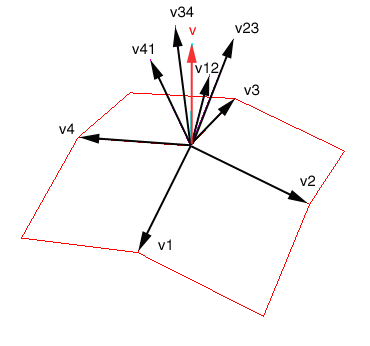


|
Terrain Tutorial Index
A TGA Library
Height Maps
Lighting
Artificial Terrain Generation
Mid Point Displacement
Smoothing |
| [Previous: Height Maps from Images] | [Next: Simulating Light] |
Terrain Tutorial
Computing Normals
To apply lighting to a terrain, either using OpenGL lights, or simulating them, it is necessary to first compute normals. A normal is a vector that defines how a surface responds to lighting, i.e. how it is lit. The amount of light reflected by a surface is proportional to the angle between the lights direction and the normal. The smaller the angle the brighter the surface will look.
Normals in OpenGL can be defined per face or per vertex. If defining a normal per face then the normal is commonly defined as a vector which is perpendicular to the surface. In order to find a perpendicular vector to a face, two vectors coplanar with the face are needed. Afterwards the cross product will provide the normal vector, i.e. a perpendicular vector to the face.
So the first step is to compute two vectors coplanar to a face. Assuming the the faces are triangles defined by points t1,t2,t3, then two possible vectors are:


v = v1 x v2
v = [vx,vy,vz] where,
vx = v1y * v2z - v1z * v2y
vy = v1z * v2x - v1x * v2z
vz = v1x * v2y - v1y * v2x
Another necessary step to obtain proper lighting is to normalise the vector, i.e. make it unit length. OpenGL takes into consideration the length of the normal vector when computing lighting. Normalisation implies first computing the lenght of the vector, and then dividing each component by the vectors length.
The length of a vector is computed as:

nv = [nvx,nvy,nvz] where,
nvx = vx / l
nvy = vy / l
nvz = vz / l
The main problem with assigning a normal per face is that the terrain looks faceted, i.e. the brightness of each face is constant, and there is a clear difference between faces with differen orientations. In order to get a smoother look normals should be computed per vertex, and not per face. When computing normals per vertex it is necessary to take into account the faces that share the vertex. So for instance if using quads, each vertex (excluding the corner and border vertices), is shared by four polygons. The normal at a vertex should be computed as the normalised sum of all the unit length normals for each face the vertex shares. Consider the following image:

The vertex normal v is computed as the normalised sum of all vij vectors:
v = normalised(sum(v12, v23, v34, v41))
where
vij = normalised(vi x vj) // normalised cross product
It is also posible to consider the eight neighbour vertices, instead of only four. This latter option will probably look smoother in the general case.
Note that when computing the normals a scale is assumed. If the application has performed non-uniform scaling the normals will no longer be correct. If scaling the heights is required use the function terrainScale provided in the terrain library. This function recomputes the normals. If the grid needs scaling then use the function terrainDim to enlarge the terrain.
| [Previous: Height Maps from Images] | [Next: Simulating Light] |